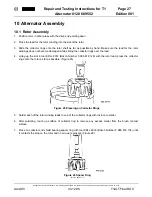
Repair and Testing Instructions for T1 Page 37
Alternator 0120 689 552
Edition 001
All rights rest with Robert Bosch Corp, including patent rights. All rights of use of reproduction and publication rest with R. B. Corp.
UA/ASV
04.12.98
T1ALTFinal.DOC
3. Hold test bench at this speed and load for 30 minutes. Monitor alternator output and speed during the test
period.
4. Remove load and operate the alternator at 7000 rpm for one minute to allow the alternator to cool.
5. Refer to the test bench operating instructions and allow the load bank to cool the required amount of time
before proceeding to the next test.
6. After the load bank has cooled, increase the test bench until the alternator has reached 6000 rpm.
7. Increase inductive load on the alternator until 136A alternator output is achieved. As load is increased,
monitor test bench speed and correct if speed drops while applying load.
8. Hold test bench at this speed and load for 10 minutes. Monitor alternator output and speed during the test
period.
9. Remove load and operate the alternator at 7000 rpm for one minute to allow the alternator to cool.
10. Refer to the test bench operating instructions and allow the load bank to cool the required amount of time
before proceeding to the next test.
11. Apply a minimum load of 10A to the alternator.
12. Measure the regulated voltage of the alternator. The correct regulated voltage is between 27.6 and 28.4
volts.
13. If the alternator passes the three output tests, no further testing is required. If the alternator failed any of the
three tests, proceed with the voltage trace evaluation.
11.3 Voltage Trace Evaluation
The voltage trace evaluation is a comparison of the voltage output of the alternator to know patterns. These
know patterns will help identify different failed components.
11.3.1 Oscilloscope Hook-up
1. Following the manufacturer's instructions for your oscilloscope, connect the scope to the B+ and B-
terminals of the alternator.
2. Adjust the oscilloscope to read 28 volts.
3. Turn on test bench and operate the alternator with a 10A load.
4. Compare oscilloscope display to the following test patterns.









































